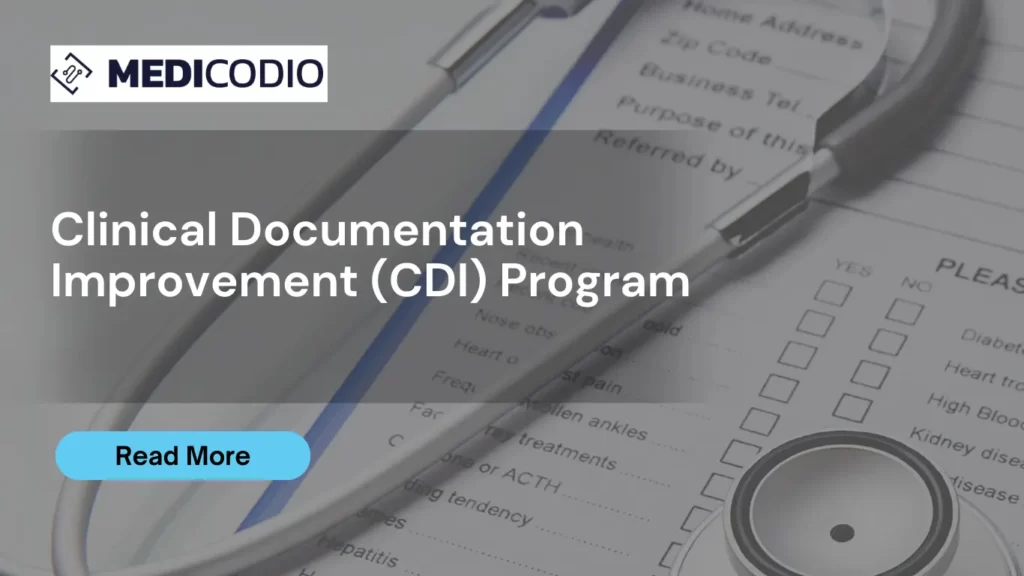In medical coding, clinical documentation is the process of creating a digital document of all the medical services provided to a patient. To ensure accurate patient clinical documentation, most healthcare facilities employ clinical documentation improvement (CDI) specialists to review each patient’s clinical documentation and make certain it is comprehensive. Incorrect medical documentation can negatively impact revenue, reimbursements, compliance, and patient experience.
A well-executed CDI program lays the foundation for improved patient care, streamlined revenue cycle management, and enhanced compliance. It brings about concrete and measurable results. According to a survey conducted by Black Book, 88 percent of hospitals documented quality improvements and increased case mix index (CMI) within six months of initiating a CDI initiative. Moreover, over 90 percent of hospitals with 150 beds or more, which outsourced their CDI programs, reported CDI-related income and reimbursement increases exceeding $2.1 million.
But why is it important to embark on this journey, and how can one forge a path toward a thriving CDI program? Let us explore the answers.
-
- Enhancing Patient Care: A successful CDI program places the patient at the center, emphasizing the importance of accurate and comprehensive clinical documentation. Capturing precise details, enables healthcare providers to make informed decisions, leading to improved diagnoses, appropriate treatment plans, and ultimately, better patient outcomes.
- Optimizing Revenue Cycle Management: In an era where financial sustainability is vital for healthcare organizations, an effective CDI program becomes valuable. Ensuring precise documentation and coding maximizes reimbursements, reduces claim denials, and minimizes audit risks. This paves the way for a healthier revenue cycle and strengthens the organization’s financial foundation.
- Fostering Compliance and Risk Mitigation: Amidst an intricate web of regulations and guidelines, a robust CDI program acts as a shield against compliance risks. Ensuring accurate documentation helps healthcare providers meet regulatory requirements, maintain transparency, and minimize the potential for legal and financial repercussions.
- Building a Collaborative Environment: A thriving CDI program thrives on collaboration and cooperation among various stakeholders. Fostering interdisciplinary teamwork, including physicians, coders, clinical documentation specialists, and administrators, creates an environment where knowledge sharing and continuous improvement flourish.
- The Key Steps to Success: a. Leadership Commitment: Establishing a CDI program requires unwavering support from organizational leaders, who should champion the cause and allocate necessary resources. b. Comprehensive Training: Equipping staff with in-depth knowledge of clinical documentation guidelines and coding principles through continuous education and training is crucial. c. Technology Integration: Harnessing the power of advanced software solutions such as CODIO can streamline workflows, automate processes, and enhance accuracy in documentation and coding. d. Data Analytics and Auditing: Regular audits and data analysis provide valuable insights into areas of improvement, identify trends, and help measure the program’s effectiveness. Continuous Evaluation and Adaptation: A successful CDI program should evolve with the changing healthcare landscape, continuously evaluate its outcomes, and adapt strategies accordingly.
A Shift Towards Value-Based Care
As the healthcare industry continues to shift towards value-based care, hospital, and physician financial executives are exploring data analytics to support reimbursement. CDI initiatives are evolving to complement this transition from volume to value, necessitating accurate and concise documentation of a patient’s health and conditions, supported by evidence. CDI has become a fundamental component of any value-based strategy, particularly when its return on investment (ROI) can be clearly understood and demonstrated.
Establishing a successful CDI program begins with identifying the pain points within an organization. These pain points may include denial rates, quality or outcome measures, capture rates of comorbidities or complications/major complications, the severity of illness/risk of mortality capture rates, over or under-coding, severity level discrepancies, and case mix index variances.
Once the primary pain points are identified, one effective model for implementing a successful CDI program is the centralized systems/decentralized specialties approach. This approach involves managing shared systems, processes, and resources through a centralized governing body while allowing each specialty to maintain decentralized documentation. This ensures that the documentation is reviewed by experts in each specific area, rather than relying solely on CDI specialists who may lack the required expertise within individual specialties.
The centralized systems/decentralized specialties model facilitates peer-to-peer collaboration, promoting acceptance of CDI while maintaining a high degree of standardization in processes and procedures. It also opens opportunities for cost reduction through near-shore, off-shore, and domestic outsourcing of standardized tasks related to CDI.
Conclusion Building a successful Clinical Documentation Improvement (CDI) program is a transformative journey that intertwines patient care, revenue cycle management, compliance, and collaboration. By following the best practices outlined above, healthcare organizations can unlock the potential for improved patient outcomes, financial stability, and a culture of excellence in clinical documentation. Let us embark on this path together, forging a future where accuracy, collaboration, and success prevail.





